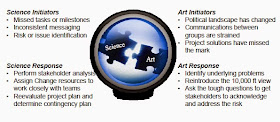Note that I'm not suggesting it's all science, just that it's probably more art, and I'm concerned that others are exaggerating the science perspective leaving art far behind. So I'm really just trying to rebalance the commentary around science and ensure art gets a look-in too.
One of the ways I'm trying to do this is through the Art of HR global conference taking place in Dubrovnik, Croatia, from 13 to 16 November 2014.
And I'm also trying to stimulate some conversation about what we mean by HR's artful role in this Linkedin group which I'd encourage you to join if you're interested.
One perspective on art and science I'd like to share was developed at my US colleagues at Buck / ACS (now Xerox) whilst I was working there as Director for Human Capital Consulting for Europe part-time seven or eight years ago. Using house building as a metaphor we suggested:
"Science represents the heavy lifter. In building terms, this would be the general
contractor, the builder or the plumber. In the world of business, this translates to
the taskmaster—the person responsible for structure, tasks and milestones.
Art represents the architect or the interior designer. In terms of your change man- agement team, this is a person, typically very well connected throughout the organization, who gathers feedback, asks “why” and is outstanding at motivating peo- ple to do things, because of his or her relationships.
Scientists are the drivers of the change, while artists are the navigators who cycle in and out, asking the questions that keep things on track. They’re the people who make sure that everyone isn’t so intent on the destination that no one realizes the car is out of gas."
"The science side is the tactical side, driven by outstanding time managers who are detail-, schedule- and task-oriented. The art side ensures that perspective and feedback get back into the system so that the outcome works for the company and accomplishes the ultimate goal."
Then the bit I really liked looked at how art and science need to link together but with one or the other leading at different stages in a project:
If all you're doing is science, you're missing out on a large piece, and potentially the most important aspects, of any change or HR project.
If you've got any other thoughts, please do join the Linkedin group and if you can, come along to the Dubrovnik conference in November.
Also see: Thoughts on the Art of HR
- Consulting - Research - Speaking - Training - Writing
- Strategy - Talent - Engagement - Change and OD
- Contact me to create more value for your business
- jon [dot] ingham [at] strategic [dash] hcm [dot] com




No comments:
Post a Comment
Please add your comment here (email me your comments if you have trouble and I will put them up for you)